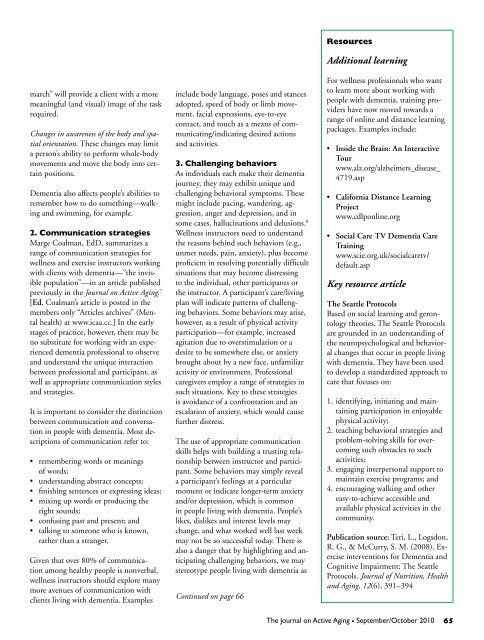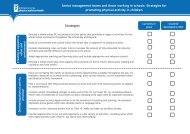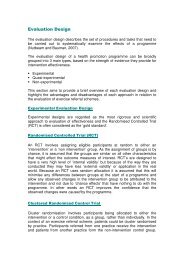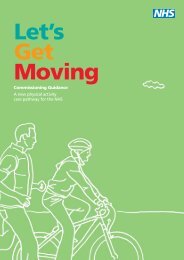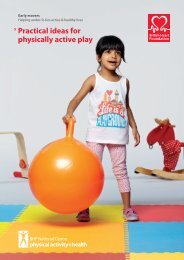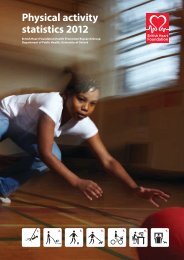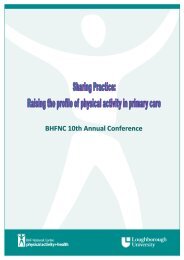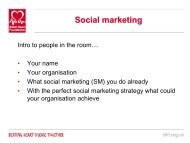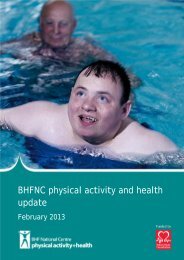Living well with dementia: guidance for exercise ... - Vida Wellness
Living well with dementia: guidance for exercise ... - Vida Wellness
Living well with dementia: guidance for exercise ... - Vida Wellness
- No tags were found...
Create successful ePaper yourself
Turn your PDF publications into a flip-book with our unique Google optimized e-Paper software.
march” will provide a client <strong>with</strong> a moremeaningful (and visual) image of the taskrequired.Changes in awareness of the body and spatialorientation. These changes may limita person’s ability to per<strong>for</strong>m whole-bodymovements and move the body into certainpositions.Dementia also affects people’s abilities toremember how to do something—walkingand swimming, <strong>for</strong> example.2. Communication strategiesMarge Coalman, EdD, summarizes arange of communication strategies <strong>for</strong><strong>well</strong>ness and <strong>exercise</strong> instructors working<strong>with</strong> clients <strong>with</strong> <strong>dementia</strong>—“the invisiblepopulation”—in an article publishedpreviously in the Journal on Active Aging. 7[Ed. Coalman’s article is posted in themembers only “Articles archives” (Mentalhealth) at www.icaa.cc.] In the earlystages of practice, however, there may beno substitute <strong>for</strong> working <strong>with</strong> an experienced<strong>dementia</strong> professional to observeand understand the unique interactionbetween professional and participant, as<strong>well</strong> as appropriate communication stylesand strategies.It is important to consider the distinctionbetween communication and conversationin people <strong>with</strong> <strong>dementia</strong>. Most descriptionsof communication refer to:• remembering words or meaningsof words;• understanding abstract concepts;• finishing sentences or expressing ideas;• mixing up words or producing theright sounds;• confusing past and present; and• talking to someone who is known,rather than a stranger.Given that over 80% of communicationamong healthy people is nonverbal,<strong>well</strong>ness instructors should explore manymore avenues of communication <strong>with</strong>clients living <strong>with</strong> <strong>dementia</strong>. Examplesinclude body language, poses and stancesadopted, speed of body or limb movement,facial expressions, eye-to-eyecontact, and touch as a means of communicating/indicatingdesired actionsand activities.3. Challenging behaviorsAs individuals each make their <strong>dementia</strong>journey, they may exhibit unique andchallenging behavioral symptoms. Thesemight include pacing, wandering, aggression,anger and depression, and insome cases, hallucinations and delusions. 8<strong>Wellness</strong> instructors need to understandthe reasons behind such behaviors (e.g.,unmet needs, pain, anxiety), plus becomeproficient in resolving potentially difficultsituations that may become distressingto the individual, other participants orthe instructor. A participant’s care/livingplan will indicate patterns of challengingbehaviors. Some behaviors may arise,however, as a result of physical activityparticipation—<strong>for</strong> example, increasedagitation due to overstimulation or adesire to be somewhere else, or anxietybrought about by a new face, unfamiliaractivity or environment. Professionalcaregivers employ a range of strategies insuch situations. Key to these strategiesis avoidance of a confrontation and anescalation of anxiety, which would causefurther distress.The use of appropriate communicationskills helps <strong>with</strong> building a trusting relationshipbetween instructor and participant.Some behaviors may simply reveala participant’s feelings at a particularmoment or indicate longer-term anxietyand/or depression, which is commonin people living <strong>with</strong> <strong>dementia</strong>. People’slikes, dislikes and interest levels maychange, and what worked <strong>well</strong> last weekmay not be so successful today. There isalso a danger that by highlighting and anticipatingchallenging behaviors, we maystereotype people living <strong>with</strong> <strong>dementia</strong> asContinued on page 66ResourcesAdditional learningFor <strong>well</strong>ness professionals who wantto learn more about working <strong>with</strong>people <strong>with</strong> <strong>dementia</strong>, training providershave now moved towards arange of online and distance learningpackages. Examples include:• Inside the Brain: An InteractiveTourwww.alz.org/alzheimers_disease_4719.asp• Cali<strong>for</strong>nia Distance LearningProjectwww.cdlponline.org• Social Care TV Dementia CareTrainingwww.scie.org.uk/socialcaretv/default.aspKey resource articleThe Seattle ProtocolsBased on social learning and gerontologytheories, The Seattle Protocolsare grounded in an understanding ofthe neuropsychological and behavioralchanges that occur in people living<strong>with</strong> <strong>dementia</strong>. They have been usedto develop a standardized approach tocare that focuses on:1. identifying, initiating and maintainingparticipation in enjoyablephysical activity;2. teaching behavioral strategies andproblem-solving skills <strong>for</strong> overcomingsuch obstacles to suchactivities;3. engaging interpersonal support tomaintain <strong>exercise</strong> programs; and4. encouraging walking and othereasy-to-achieve accessible andavailable physical activities in thecommunity.Publication source: Teri, L., Logsdon,R. G., & McCurry, S. M. (2008). Exerciseinterventions <strong>for</strong> Dementia andCognitive Impairment: The SeattleProtocols. Journal of Nutrition, Healthand Aging, 12(6), 391–394The Journal on Active Aging • September/October 2010 65


